14 of the Best Hip Labral Tear Treatments
Feeling the pain from a hip labral tear?
These are the best treatment options - surgical and non-surgical.
Related Articles
- Labral Tear: Injury Overview
- The Best Hip Labral Tear Treatments
The Best Hip Labral Tear Exercises - Physical Therapy for a Hip Labral Tear
A hip labral tear involves injury to the labrum, the cartilage ring surrounding the hip joint. The labrum provides support and stability to the hip. When a tear occurs, it can lead to a variety of symptoms, including:
- Hip pain, especially during rotation
- Pain that radiates to the groin or back
- Instability of the hip
- Stiffness
- A clicking sound in the hip
- Decreased range of motion in the hip
Hip labral tears may occur on the side of the joint closer to the belly, which is an anterior tear. Repetitive pivoting movements may lead to an anterior hip labral tear. Posterior tears occur on the side of the joint that is closer to the back. Tears to the anterior side are more common.
Hip labral tears may occur due to excessive force placed on the labrum. A hip labral tear can happen to anyone and does not appear to be an age-related injury.
The injury can occur from traumatic injuries, which are from a sudden event, such as a fall. In other cases, a degenerative tear occurs from repetitive activities like playing a certain sport.
Activities and sports that require frequent external rotation or hyperextension of the hip may increase the risk of an injury. Individuals who participate in the following sports may increase their risk of a hip labral tear:
- Soccer
- Gymnastics
- Dance
- Hockey
- Football
- Sprinting
Nonsurgical Treatments
There are different types of hip labral tear treatment based on the tear's severity and symptom level. Getting an accurate diagnosis is vital to receive the most appropriate treatment. Non-surgical treatment may be an option for minor tears.
However, it is essential to remember that hip labral tears do not heal independently without surgery. But if a tear is small and does not limit mobility, non-surgical treatment may help.
Hip labral tear healing without surgery may include various options, including those listed below.
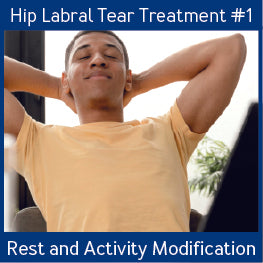
Rest and Activity Modification
The torn labrum leads to inflammation around the hip joint. Resting the hip area and modifying activities that may contribute to pain is helpful. Reducing certain activities may allow time for the inflammation and symptoms to decrease before returning to normal activities.

Medications
Medication may also help treat a hip labral tear. Over-the-counter non-steroidal anti-inflammatory medications (NSAIDs) may provide hip labral tear pain relief and reduce inflammation. However, NSAIDs have limits and are likely not enough to knock out significant pain. They can also have side effects like diarrhea, indigestion, and dizziness.
Taking NSAIDs for more than 10 days is often not recommended. As always, it is best to talk with a doctor before adding medications.
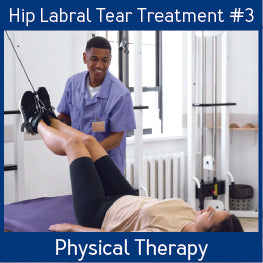
Physical Therapy
Physical therapy can help improve flexibility, increase range of motion, help strengthen the muscles that support the hip, and promote joint stability. Therapists can also help teach people movements to avoid putting stress on the hip.
The exact length of time someone undergoes physical therapy may vary. But it may include a 10-12 week program that includes exercise, stretching, cryotherapy, strengthening exercise, and other interventions.
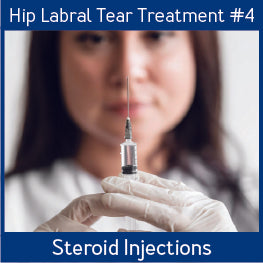
Steroid Injections
Steroid injections help decrease inflammation, which allows the femoral head and acetabulum to move smoother without pain. However, the injection does not help heal the tear. Also, steroid injections have potential side effects, such as:
- Temporary increase in blood sugar
- Possible increase in blood pressure
- Fluid retention
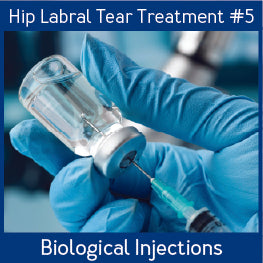
Biological Injections
Biological injections may include stem cell injections and platelet-rich plasma (PRP) injections.
Stem cell injections involve extracting stem cells, usually from the patient’s body, possibly from the pelvic bone. After the stem cells are separated from other cells and substances, they are injected into the hip joint. The goal is for the stem cells to promote healing and regrowth of the damaged tissue.
PRP therapy is also an option as a newer form of biologic therapy. The process starts by taking a small amount of blood through the vein. A centrifuge machine extracts the platelets from the blood. The result is a liquid called plasma, which is injected into the hip.
The plasm is thought to release growth factors that help stimulate the reparative cells in the body to enhance healing. Although research is ongoing, PRP may help reduce pain and improve function in people with a hip labral tear.

TENS Therapy
TENS therapy involves transcutaneous electrical nerve stimulation to reduce pain. It is a battery-powered device with attached electrodes placed near the painful area. The electrodes deliver low-voltage electrical current to the surface of the skin.
Researchers believe TENS therapy works by effectively blocking pain or changing how the body perceives pain. It can ease hip labral pain and make movement more manageable.
Healthcare providers may provide TENS therapy. Devices are also available to use at home.
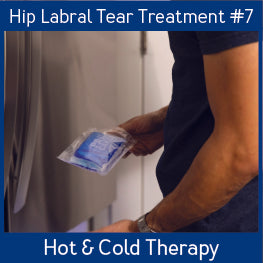
Hot & Cold Therapy
Hot & cold therapy can also be beneficial for hip labral tear home treatment. Cold therapy can constrict the blood vessels, which reduces pain and inflammation. Heat therapy dilates the blood vessels, which improves blood flow to the area and may help decrease stiffness.
The exact way you do hot & cold therapy may vary. Try each one and determine what works best. You may also want to try alternating hot & cold therapy. You can apply cold for one minute and switch to heat for 3 minutes, continuing to rotate for 15 minutes.

Acupuncture
Acupuncture involves the insertion of tiny needles through the skin at specific points in the body. An acupuncturist inserts the needles into various depths and may gently twist or move the needles once inserted.
Researchers believe that acupuncture may stimulate the central nervous system. This stimulation may cause the release of certain chemicals that reduce pain. Although acupuncture cannot repair a hip labrum tear, it may help manage discomfort.

Compression and Support
Compression braces or tape can support the hip joint and surrounding muscles and tendons. A compression brace may help reduce pain by preventing excess hip flexion and providing structural support. In addition to taping, hip labrum support braces are available and may offer more support than tape.

Exercise
Exercise can strengthen the muscles that support the hip joint. Exercise may also promote range of motion and decrease stiffness. While exercise can play a critical role in rehabilitating a hip labrum tear, doing the right exercises for the type of injury is essential.
Surgical Treatments
Torn hip labrum treatment options may also include surgical procedures. Surgery may be recommended in cases where a more significant tear affects mobility and causes pain. If hip labral tear home treatment does not work and other medical interventions do not help, surgery may be needed.
In some instances, the pain might initially be reduced, but the discomfort may return when someone resumes their everyday activities. This may also indicate surgery is the next option.
Different forms of surgery for hip labral tear treatment are available. The most appropriate option may depend on the extent of the tear and how much tissue damage occurred. Options include those listed below.
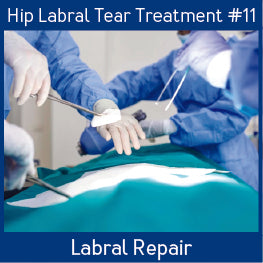
Labral Repair
In some instances, the tear to the labrum is bad enough that the surgeon cannot just stitch it together. A hip labral repair may be an option if the labrum separates from the bone.
During the procedure, the surgeon reattaches the torn labrum to the acetabulum using small anchors made of plastic or metal. These anchors hold the labrum in place.
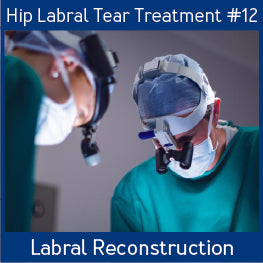
Labral Reconstruction
A hip labral reconstruction surgery might be necessary if there is insufficient healthy tissue to repair the labrum. Instead, the surgeon rebuilds the labrum.
Hip labral reconstruction surgery involves using a graft to reconstruct or rebuild the torn part of the labrum. The donor tissue to graft may come from the patient or another person.
Different techniques may be an option, such as focusing on a segmental reconstruction or a broader procedure.
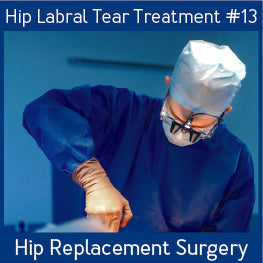
Hip Replacement Surgery
Individuals with a history of hip labral tear may have an increased risk of developing osteoarthritis. If osteoarthritis in the hip develops and becomes severe, a hip replacement may be needed.
Hip replacement surgery involves removing the damaged femoral head and replacing it with a metal stem placed in the center of the femur. Next, the surgeon places a metal ball on the upper part of the stem. The damaged acetabulum is removed and replaced with a metal socket. The doctor places a metal spacer between the new ball and socket, allowing for smooth movement.
After a hip replacement, an individual undergoes physical therapy to aid healing and recovery.
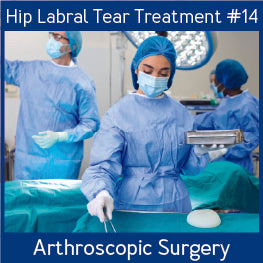
Arthroscopic Surgery
One type of minimally invasive surgical procedure for hip labral tear treatment is arthroscopic surgery. During the procedure, the surgeon makes small incisions in the skin to access the hip. Using an arthroscope, a special camera device, the doctor locates the tear, removes frayed tissue, and stitches the tear together.
Because the incisions are small, it is less invasive than other forms of hip surgery. Benefits include:
- Less bleeding
- Faster recovery
- And a reduced risk of infection.
Recovery Tips
Recovery time from a hip labrum tear may depend on a few factors, such as the extent of the tear, underlying health conditions, and age. But there are steps someone can take to promote healing. Consider the following recovery tips:
- Do not delay seeing a healthcare provider and starting treatment.
- Be consistent with home hip labrum treatment.
- Limit activity that causes hip pain.
- Do home physical therapy exercises as directed by your therapist.
- Follow post-operative instructions if you undergo some form of hip labrum surgery, such as incision care and weight-bearing restrictions.
- Gradually return to normal activities and do not overdo it.
Conclusion
A hip labrum tear can lead to pain and instability of the hip and interfere with normal movement. Treatment may help decrease pain and improve functioning. Minor tears that cause minimal symptoms may respond to hip labral tear home treatment, such as modification of activity, physical therapy, and NSAIDs. Additional hip labral tear healing without surgery may include TENS therapy, hot & cold therapy, and acupuncture.
In cases where home treatment is not effective or in more severe tears, surgery is needed. Surgical options include minimally invasive arthroscopic surgery to stitch the tear. Depending on the severity of the tear, a labrum repair or reconstruction may be required. In the most severe cases, a hip replacement may be recommended when other labrum surgical procedures are not an option.
Seeing your healthcare provider is vital for an early diagnosis and management. Getting a diagnosis early may reduce the risk of further damage and help someone get on the road to recovery faster.
About the Author

MaryAnn DePietro CRT is a licensed respiratory therapist with over 15 years of clinical experience in critical care, emergency medicine, and pulmonary rehabilitation. She is also an American Council on Exercise certified personal trainer and holds specialty certifications in orthopedics, senior fitness, and weight management. MaryAnn has a degree in Rehabilitation from Penn State University and a degree in respiratory therapy.
In addition to her clinical experience, she has written extensively about all things medical, as well as health, fitness, and aging for various websites, magazines, and newspapers.
About Carex Health Brands
Carex is your one-stop shop for home medical equipment and for products that assist caregivers with providing the best possible support and care for their loved ones. Carex Health Brands has been the branded leader in in-home, self-care medical products for over 35 years. Our goal is to improve the lives of our customers by bring them quality products that bring dignity back to their lives. With our three nationally distributed brands, Carex Health Brands serves national, regional and independent food, drug and mass retailers along with wholesalers, distributors and medical dealers.

